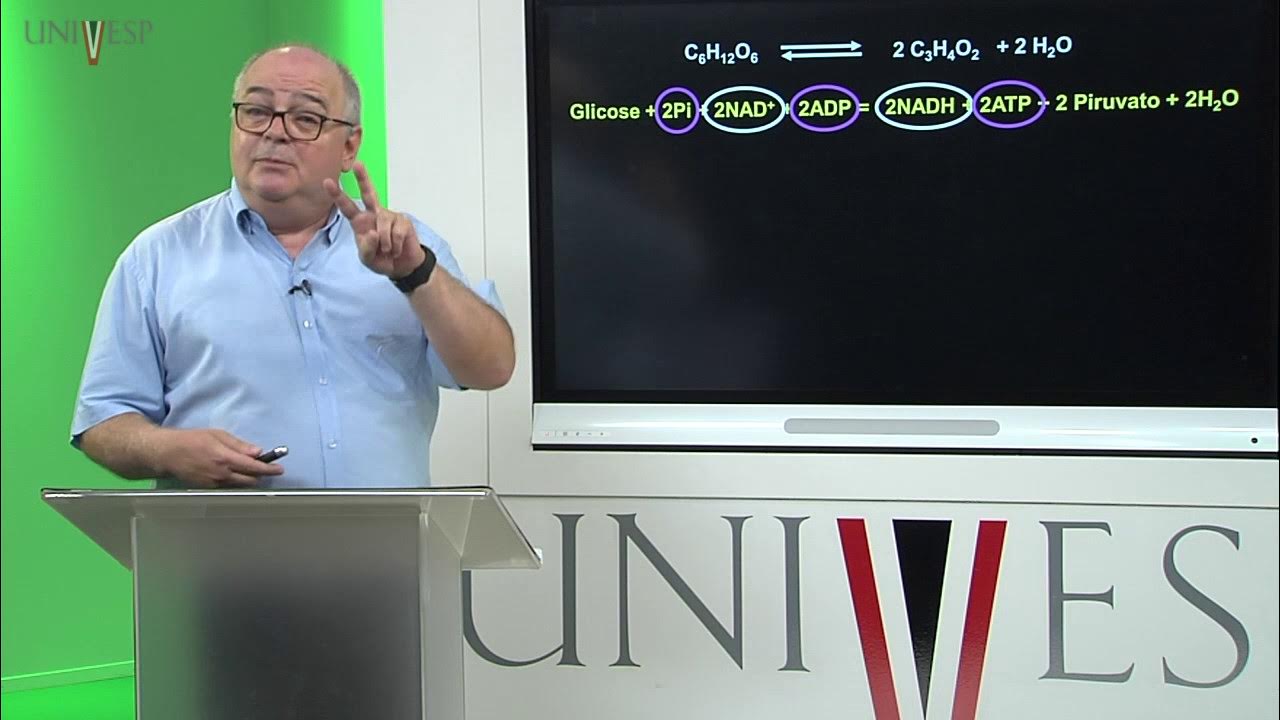Bioquímica - Aula 18 - Anabolismo
Summary
TLDRIn this lecture, Professor Ângelo Cortelazzo explains the biochemical processes of metabolism, focusing on anabolism and glycolysis. He outlines the role of glucose as a key energy source and how it is synthesized and degraded in the body. The lecture explores the importance of energy in cellular processes, including the creation of ATP, and discusses gluconeogenesis, where the body produces glucose from non-carbohydrate precursors. Additionally, the professor highlights the interconnection between catabolic and anabolic pathways, emphasizing how cells adjust metabolic processes to meet energy demands.
Takeaways
- 😀 Anabolism refers to the series of reactions in organisms that synthesize compounds needed for their survival, including glucose production and energy storage.
- 😀 The body has a limited reserve of glucose in the form of glycogen, stored primarily in the liver and muscles. This reserve is enough for just a few hours of energy usage.
- 😀 Certain tissues, like red blood cells, rely exclusively on glucose for energy, consuming about 30 grams per day. The brain and nervous tissue use even more, around 120 grams per day.
- 😀 Glycogen stores are not sufficient for long-term energy needs, and alternative energy sources, like fatty acids and ketone bodies, are used during longer periods of fasting or energy depletion.
- 😀 The process of gluconeogenesis allows the body to produce glucose from non-carbohydrate sources, especially during times when glucose is scarce.
- 😀 Some reactions in glucose metabolism are nearly irreversible, particularly those with a highly negative free energy change (ΔG), such as glucose to glucose-6-phosphate.
- 😀 Reactions with negative ΔG, like those involving the conversion of glucose to fructose-1,6-bisphosphate, are tightly regulated to ensure they proceed in the correct direction.
- 😀 The body can also bypass some of the irreversible reactions in glucose metabolism by using alternative pathways, such as the conversion of pyruvate to oxaloacetate to aid in gluconeogenesis.
- 😀 Malate plays a crucial role in transporting energy and metabolites across mitochondrial membranes, supporting processes like gluconeogenesis and energy production.
- 😀 Both catabolic (breaking down) and anabolic (building up) processes share similar metabolic pathways but operate in opposite directions, with energy usage being a key factor in these processes.
Q & A
What is anabolism and how does it differ from catabolism?
-Anabolism refers to the series of biochemical reactions that involve the synthesis of complex molecules from simpler ones. It requires energy input. In contrast, catabolism involves the breakdown of complex molecules into simpler ones, releasing energy in the process.
Why is glucose an important compound for the human body?
-Glucose is crucial for energy production, especially for tissues like the brain and red blood cells that rely exclusively on glucose for energy. It is stored as glycogen in the liver and muscles and is used as a primary energy source.
What happens when the body's glycogen reserves are depleted?
-When glycogen reserves are low, the body turns to alternative energy sources, such as lipids (fatty acids) and proteins. It can also initiate gluconeogenesis to produce glucose from non-carbohydrate sources, ensuring a steady energy supply for tissues that require glucose.
What are the three key irreversible reactions in glucose metabolism?
-The three key irreversible reactions are: 1) The conversion of glucose to glucose-6-phosphate, 2) The conversion of fructose-6-phosphate to fructose-1,6-bisphosphate, and 3) The conversion of phosphoenolpyruvate to pyruvate. These reactions are critical in regulating glycolysis and gluconeogenesis.
How does the body bypass the irreversibility of certain metabolic reactions?
-The body bypasses irreversible reactions by using alternative pathways or enzymes. For example, in gluconeogenesis, certain reactions in glycolysis are reversed through the use of different enzymes to ensure glucose synthesis, despite the original reactions being energetically unfavorable in the opposite direction.
What role does oxaloacetate play in metabolic processes?
-Oxaloacetate is a key intermediate in several metabolic pathways, including gluconeogenesis and the citric acid cycle (Krebs cycle). It can be produced from pyruvate and helps in the formation of glucose and other metabolic intermediates.
Why is fructose-1,6-bisphosphate important in glucose metabolism?
-Fructose-1,6-bisphosphate is an important intermediate in glycolysis and gluconeogenesis. Its regulation plays a critical role in controlling the flow of glucose through these pathways, and it can be hydrolyzed to produce energy or participate in glucose synthesis.
What is the function of ATP in both catabolic and anabolic processes?
-ATP serves as the primary energy currency in both catabolic and anabolic processes. In catabolism, ATP is produced through the breakdown of molecules. In anabolism, ATP is consumed to drive the synthesis of complex molecules.
How does the presence of ATP and ADP affect metabolic reactions?
-The levels of ATP and ADP are key regulators of metabolic reactions. High ATP levels promote anabolic reactions (energy storage and synthesis), while high ADP or low ATP levels trigger catabolic reactions to produce energy and restore ATP balance.
What are the implications of gluconeogenesis in energy metabolism during fasting or hypoglycemia?
-During fasting or hypoglycemia, gluconeogenesis becomes critical for maintaining blood glucose levels, especially for tissues like the brain that rely on glucose for energy. This process converts non-carbohydrate precursors, such as amino acids and glycerol, into glucose.
Outlines

This section is available to paid users only. Please upgrade to access this part.
Upgrade NowMindmap

This section is available to paid users only. Please upgrade to access this part.
Upgrade NowKeywords

This section is available to paid users only. Please upgrade to access this part.
Upgrade NowHighlights

This section is available to paid users only. Please upgrade to access this part.
Upgrade NowTranscripts

This section is available to paid users only. Please upgrade to access this part.
Upgrade Now5.0 / 5 (0 votes)





